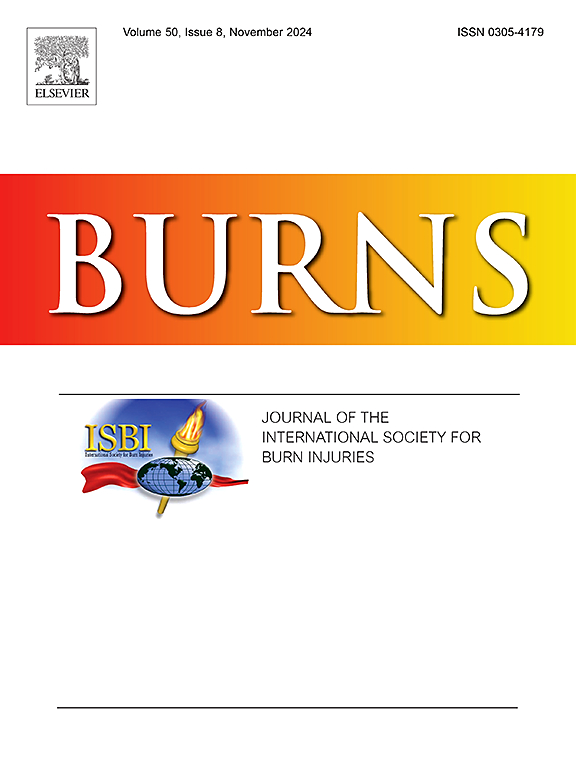Preliminary exploration of efficacy assessment and optimal concentration of teprenone oral rehydration solution for the early management of post-burn shock
IF 2.9
3区 医学
Q2 CRITICAL CARE MEDICINE
引用次数: 0
Abstract
Objective
To evaluate therapeutic efficacy of teprenone-enriched oral rehydration solution (TORS) relative to World Health Organization’s recommended Oral Rehydration Solution (WHO-ORS) and identify the optimal concentration of TORS for early burn shock intervention.
Methods
A total of 350 male Wistar rats (200–220 g) were randomly divided into seven groups (n = 50/group): Sham (no burn and no treatment) group, Burn (no treatment) group, WHO-ORS group, and four concentrations of TORS (TRS1–TRS4). All groups, except Sham group, were subjected to 50 % total body surface area (TBSA) third-degree scald burns. Resuscitation protocols commenced immediately post-burn and continued every 2 h for 8 h, delivering TORS at 2 mL/kg/%TBSA (modified Brooke formula). Survival rates were measured at 72 h post-burn. High-resolution laser Doppler was used for gastric blood flow measurement; gastrointestinal mucosal damage was assessed via optical and transmission electron microscopy; blood teprenone levels were determined using reverse-phase high-performance liquid chromatography. Lactate, hematocrit, hemoglobin, malondialdehyde, superoxide dismutase, and interleukin-33 levels were analyzed.
Results
TORS administration resulted in higher 72- h survival rates in both Burn and WHO-ORS controls (P < 0.01 for TRS2 vs Burn), while exhibiting dose-dependent serum teprenone absorption. All TORS groups exhibited improved gastric blood flow, reduced gastric mucosal damage, and better performance in other measured parameters than the WHO-ORS group and Burn group. The TRS2 concentration was closest to the Sham group in most of the studied parameters.
Conclusion
The newly formulated TORS proved to be effectively emptied and absorbed by the gastrointestinal tract. This study establishes TORS as a viable oral resuscitation strategy, with TRS2 demonstrating optimal efficacy in improving tissue perfusion and survival outcomes over WHO-ORS, thereby offering a promising approach for early burn shock management. Further investigations are required to elucidate its underlying mechanisms.
替普利酮口服补液早期治疗烧伤后休克疗效评价及最佳浓度的初步探讨
目的对比世界卫生组织推荐的口服补液(WHO-ORS),评价富戊二酮口服补液(TORS)的治疗效果,确定早期烧伤休克干预的最佳口服补液浓度。方法取350只雄性Wistar大鼠(200 ~ 220 g),随机分为7组(n = 50只/组):Sham(不烧伤不治疗)组、burn(不治疗)组、WHO-ORS组和4种浓度的TORS (trs1 ~ trs4)。除Sham组外,所有组均进行50% %体表面积(TBSA)的三度烫伤。复苏方案在烧伤后立即开始,每2小时持续8 小时,以2 mL/kg/%TBSA(修改布鲁克公式)提供TORS。在烧伤后72 h测量生存率。采用高分辨率激光多普勒测量胃血流量;通过光学显微镜和透射电镜评估胃肠道粘膜损伤;采用反相高效液相色谱法测定血tepreone水平。分析乳酸、红细胞压积、血红蛋白、丙二醛、超氧化物歧化酶和白细胞介素-33水平。结果在烧伤组和WHO-ORS对照组中,stors的72- h生存率均较高(TRS2 vs Burn的P <; 0.01),同时血清中tepreone的吸收呈剂量依赖性。与WHO-ORS组和Burn组相比,所有TORS组均表现出胃血流量改善,胃黏膜损伤减少,其他测量参数的表现更好。在大多数研究参数中,TRS2浓度与Sham组最接近。结论新配制的TORS能有效排空并被胃肠道吸收。本研究确立了TORS是一种可行的口服复苏策略,与WHO-ORS相比,TRS2在改善组织灌注和生存结果方面表现出最佳效果,从而为早期烧伤休克治疗提供了一种有希望的方法。需要进一步的研究来阐明其潜在的机制。
本文章由计算机程序翻译,如有差异,请以英文原文为准。
求助全文
约1分钟内获得全文
求助全文
来源期刊

Burns
医学-皮肤病学
CiteScore
4.50
自引率
18.50%
发文量
304
审稿时长
72 days
期刊介绍:
Burns aims to foster the exchange of information among all engaged in preventing and treating the effects of burns. The journal focuses on clinical, scientific and social aspects of these injuries and covers the prevention of the injury, the epidemiology of such injuries and all aspects of treatment including development of new techniques and technologies and verification of existing ones. Regular features include clinical and scientific papers, state of the art reviews and descriptions of burn-care in practice.
Topics covered by Burns include: the effects of smoke on man and animals, their tissues and cells; the responses to and treatment of patients and animals with chemical injuries to the skin; the biological and clinical effects of cold injuries; surgical techniques which are, or may be relevant to the treatment of burned patients during the acute or reconstructive phase following injury; well controlled laboratory studies of the effectiveness of anti-microbial agents on infection and new materials on scarring and healing; inflammatory responses to injury, effectiveness of related agents and other compounds used to modify the physiological and cellular responses to the injury; experimental studies of burns and the outcome of burn wound healing; regenerative medicine concerning the skin.
 求助内容:
求助内容: 应助结果提醒方式:
应助结果提醒方式:


